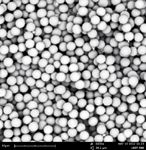Introducing Titan UHPLC Columns Featuring Monodisperse Porous Particles
The Application Notebook
Supelco
A careful investigation of columns prepared with monodisperse, solid-core silica particles has shown that an important contribution to their surprising efficiency arises from a very low eddy diffusion (multipath) term in van Deemter plots. The very narrow particle size distribution of 6% RSD for 2.7 μm Fused-Core® silica particles may create more uniform column beds and flow paths than particles with broader distribution.
Uniform column beds may also preserve initial high efficiency by providing more resistance to voiding and channeling under variable flow and pressure conditions. If small porous silica particles can be made economically with a similar narrow size distribution, they may also allow preparation of columns with higher efficiency and greater bed stability. Because porous silica particles made by usual processes have broader distribution and can be costly to size, a new process was developed to create silica particles that are already monodisperse and ready-to-use for UHPLC. The unique process allows monodisperse silica to be prepared in a range of porosities and sizes with <6% RSD.
Previously, a size range of 15–25% RSD has been more typical for porous silica particles, even after special sizing procedures have been applied. Titan™ columns prepared with monodisperse 1.9 μm C18 silica have exhibited more than 300,000 plates per meter for small molecules and can greatly enhance the performance of UHPLC instruments. Titan UHPLC columns are the outcome of the patent pending Ecoporous™ process, a process that provides an economical route to UHPLC grade silica.

Figure 1: Titan 1.9 μm SEM photo.
Titan exhibits the narrowest particle size distribution for any known UHPLC grade porous silica. Figure 1 shows an SEM image of the Titan silica. D90/10 values have been consistently measured less than 1.2 for this silica. Chromatographic data for two column internal diameters is shown in Figure 2 for a set of probes including a pharmaceutical base. Excellent efficiency and peak shape are demonstrated in this data set.

Figure 2: Titan C18 performance at different column i.d.s, columns: Titan C18, 1.9 μm, mobile phase: 50% acetonitrile, temp.: 35 °C, det.: 254 nm. Peaks: 1. Uracil, 2. Diazepam, 3. Toluene, 4. Naphthalene, 5. Biphenyl.
In conclusion, our results indicate a higher performance to pressure ratio for Titan columns compared to many commercial UHPLC columns. Very narrow PSD porous silica promises to become another important development in this era of rapid advancements in UHPLC technology.
Titan and Ecoporous are trademarks of Sigma-Aldrich Co LLC. Fused-Core is a registered trademark of Advanced Materials Technology, Inc.

Supelco/Sigma-Aldrich
595 North Harrison Road, Bellefonte, PA 16823
tel. (800) 359-3041, (814) 359-3441
Website: sigma-aldrich.com/analytical

SEC-MALS of Antibody Therapeutics—A Robust Method for In-Depth Sample Characterization
June 1st 2022Monoclonal antibodies (mAbs) are effective therapeutics for cancers, auto-immune diseases, viral infections, and other diseases. Recent developments in antibody therapeutics aim to add more specific binding regions (bi- and multi-specificity) to increase their effectiveness and/or to downsize the molecule to the specific binding regions (for example, scFv or Fab fragment) to achieve better penetration of the tissue. As the molecule gets more complex, the possible high and low molecular weight (H/LMW) impurities become more complex, too. In order to accurately analyze the various species, more advanced detection than ultraviolet (UV) is required to characterize a mAb sample.

.png&w=3840&q=75)

.png&w=3840&q=75)



.png&w=3840&q=75)



.png&w=3840&q=75)













